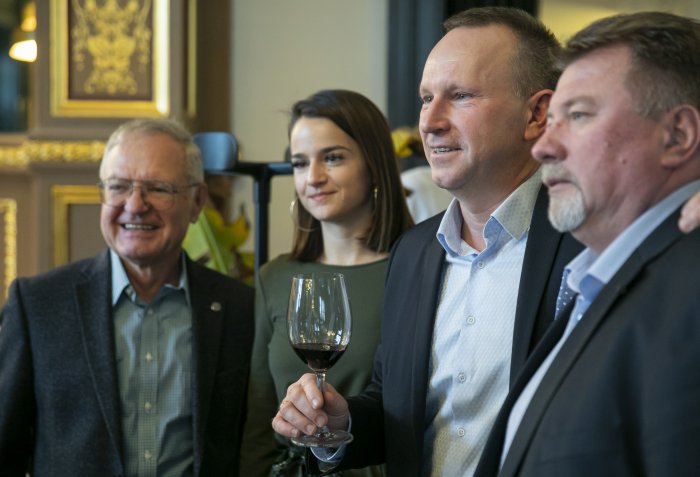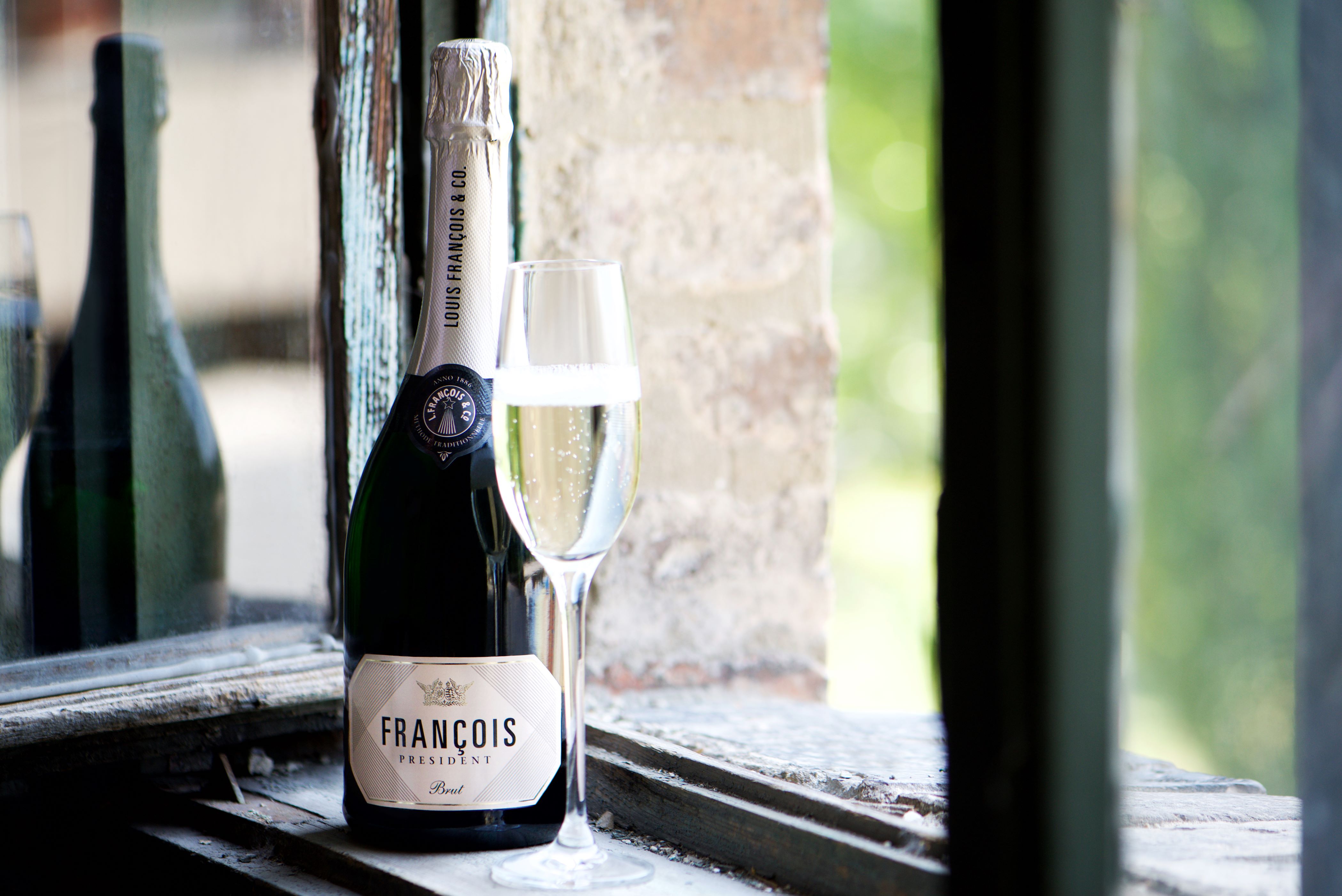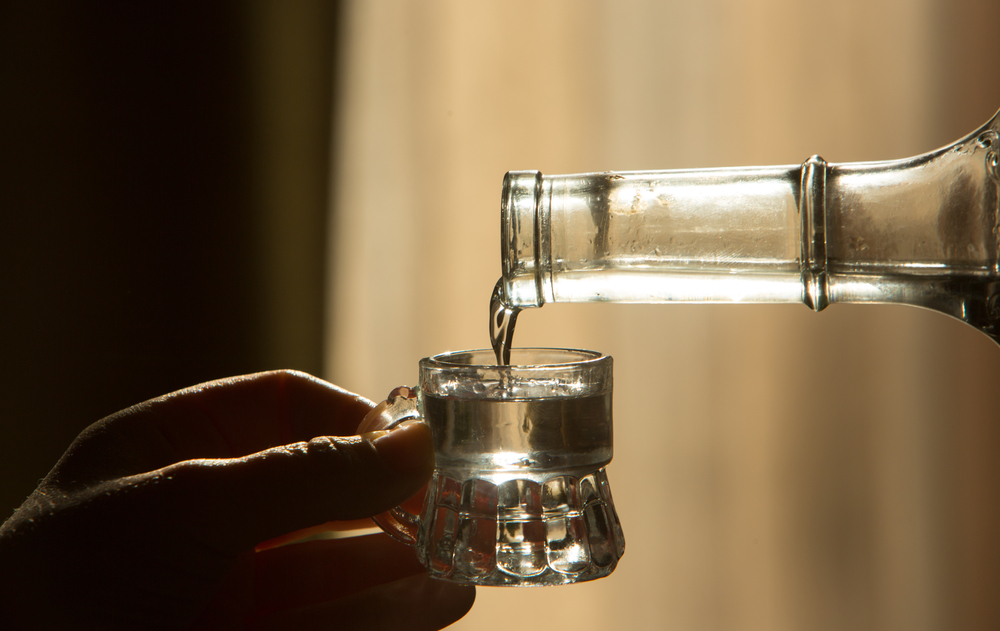Koch Joins Hungaryʼs Winemaking Greats

Balázs Mohai
Downstairs at the Great Market Hall, after you pass the pungent pickles stalls and the engagingly eerie sight of live (just) if resigned-looking carp and catfish crammed into tanks at the fishmongers, you come to Bor tér (Wine square), part of Hungarikum utca, which pays homage to all things uniquely Hungarian, from Magyar foodstuffs and tipples, to Ányos Jedlik’s soda syphon, and from Zsolnay porcelain to the Rubik’s Cube.
Hungarian Winemaker of the Year 2019, Csaba Koch (holding glass).
Bor tér not only provides a concise summary display of Hungary’s wine regions and grape varieties (in English and Hungarian), it also has plaques on its walls that honor the 29 people to have been named Winemaker of the Year, a title awarded every year since 1991 by the Hungarian Wine Academy (Magyar Bor Akadémia).
It was here on January 22 that the plaque was unveiled for the 2019 winner, Csaba Koch, who makes his wine mainly in the lesser-known region of Hajós-Baja at his eponymously-named winery, although he also makes a portion of his wine in the more highly coveted and much better known Villány, where he bottles under the name of Vin Art.
“Receiving the award is not only a great honor, but also a great responsibility,” said Koch, referring to the commitment to quality that the award entails, on joining an impressive list of former winners. His comments are more than mere words; the 2005 winner, Eger’s Béla Vincze, was later hit by a scandal, but has worked hard to reinstate his reputation.
A glance at the Winemaker of the Year list is a veritable “Who’s Who” of the Hungarian winemaking firmament and works its way up and down the land, and even beyond (into present day Romania in the case of 2018 winner Géza Balla from the Ménes region, near Arad) and it doesn’t just focus on the most esteemed regions.
While it is easy to be cynical regarding the selection of certain winners, a glance at the ever-lengthening list does give credit where credit’s due.
Koch is a more than worthy winner, for his ability to achieve unerring quality, from clean, correct wines that certainly do what they say on the packet and give good bang for the buck, to more complex and exciting offerings.
Clean and Floral
Koch Frisch Irsai Olivér 2019 (HUF 1,815 from the winery’s webshop) is clean, floral (think elderflower and roses) and fruity (especially lychee) with good concentration and the kind of vibrant acidity that this extremely aromatic grape often lacks, doing a good bit more than the grape says on the packet.
This grape can promise plenty on the nose, only to give way to a short and flabby palate. It comes from a low yield per vine (much more concentrated than most Irsai) and from Koch’s best vineyards and is vinified in stainless steel.
Koch, who makes around 800,000 bottles of wine a year from 150 hectares (10 of which are in Villány), told the Budapest Business Journal that the 2019 vintage was very good indeed, with a nice combination of warmth and rain at the right time, resulting in very good aromas, as well as balanced acidity and nice concentration. “The wines are looking good,” he said.
The high limestone content in the soil in Hajós-Baja (basically the other side of the Danube to Szekszárd, with loess in common with that region, rather than the sandy soils more typical of the other regions of the Great Plain) helps preserve the acidity, and even enables traditional method sparkling wine to be made, according to Koch.
Interestingly, the grapes for Koch 2016 Chardonnay Brut Pezsgő 2016 (HUF 4,400) were harvested at the same time as the grapes for his premium Chardonnay still wine, though the result is good.
Usually grapes in Champagne and for most traditional method sparkling wines are harvested quite early, when the acids are high and the alcohol is low. However, when I was in Champagne visiting lots of smaller producers, there were plenty who challenged that assumption and sought to make more “vinous” Champagne from later harvests.
Koch’s Vin Art Cabernet Franc 2016, shows that he can mix it with the Villány big guns: it has nice concentration and balance, as well as that characteristic tobacco leaf note of good Cab Francs.
10th Generation
Csaba Koch is the 10th generation of his family to be involved in wine growing and has been making wine for a living for 29 years. He is also experimenting with grapes that do not require spraying with pesticides. The traditional gala dinner that will feature dishes made by various chefs around the Winemaker of the Year’s will be held on February 9 at the InterContinental Budapest.
February is also when the tasting season gets going again, with the 15th Ball of Hungarian Wines (Magyar Borok Bálja) happening on February 15, which will include 100 leading wines to go with food, along with a host of other activities.
In local wine terms, February also stands for Furmint February, with the centerpiece grand tasting event, replete with 200 wines poured by the people who made them, held at its usual grand venue of the Hungarian Agricultural Museum, on February 6.
Hungary’s flagship white grape variety has come a long way in the 11 years Furmint February has been held, and an offshoot tasting was due to be held just before we went to pint in London on January 29, following on from its debut last year – with 36 wines at this year’s tasting, open to consumers (at a cost of GBP 27), following the trader and press tasting.
The London event was also due to include a masterclass celebrating 20 years of dry Furmint, by Carolyn Gilby, Master of Wine, who observed that it has recently been discovered that Furmint has a common parent to Riesling and Chardonnay in the now barely planted Gouais Blanc.
Actually, in a practice blind tasting of international wines I was recently involved in, a wine came up that some thought was a German Riesling, and I thought a Chardonnay from Chablis, France. It was, in fact, a dry Furmint from Tokaj, from the Szent Tamás winery in Mád, which nobody was expecting!

SUPPORT THE BUDAPEST BUSINESS JOURNAL
Producing journalism that is worthy of the name is a costly business. For 27 years, the publishers, editors and reporters of the Budapest Business Journal have striven to bring you business news that works, information that you can trust, that is factual, accurate and presented without fear or favor.
Newspaper organizations across the globe have struggled to find a business model that allows them to continue to excel, without compromising their ability to perform. Most recently, some have experimented with the idea of involving their most important stakeholders, their readers.
We would like to offer that same opportunity to our readers. We would like to invite you to help us deliver the quality business journalism you require. Hit our Support the BBJ button and you can choose the how much and how often you send us your contributions.









